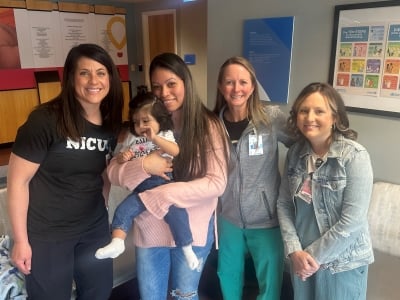Persistent Pulmonary Hypertension of the Newborn (PPHN): Isaac’s Story
Meet Isaac

Isaac is an on-the-go kid who loves farm animals and his big brother and sister. “He wants to be running around with his siblings,” said Isaac’s mom, Mayra. “He wants to be in the crowd.” Isaac also knows his mind. “If he doesn’t get his way, the world’s gonna end!” Mayra laughed.
That determination powered Isaac through some difficult early weeks. You wouldn’t know it now from his yell, but Isaac started life with very low oxygen levels.
A few days away from a scheduled C-section, Mayra and her husband, Luis, went to the emergency room when Mayra noticed Isaac’s movements had slowed. Isaac was born by emergency C-section in Wichita at Ascension Via Christi Health System, where the Neonatal Intensive Care Unit (NICU) is affiliated and staffed by Children’s Mercy neonatologists.
Isaac was a big baby (13 pounds) with multiple challenges. He had an enlarged heart with a compressed left ventricle that made it difficult to pump oxygenated blood to the body. He had inhaled meconium (a baby’s first stool) during birth, and the blood vessels in his lungs were very tight — persistent pulmonary hypertension of the newborn (PPHN). His kidneys were struggling, too.
Isaac was put on ventilator support right away. His team initiated therapeutic hypothermia, a cooling technique that can help prevent brain damage in medically complex newborns like Isaac. But after two days, his oxygen levels were still dropping.

“We were quickly losing ground and running out of medical management options,” said Danielle Reed, MD, FAAP, Neonatology, who was working at the Via Christi NICU that day. “We were on borrowed time. We needed to get him on ECMO.”
Extracorporeal membrane oxygenation (ECMO) is a special kind of life support that functions as a patient’s heart and lungs. It pumps blood from the patient’s body through an artificial lung that adds oxygen and removes carbon dioxide. That oxygenated blood goes back into the body, letting the patient’s heart and lungs rest and heal.
“ECMO is a team sport,” said John Daniel, MD, MS, Neonatal ECMO Director. “It really requires everybody.” The NICU ECMO care team includes neonatologists, surgeons, clinical pharmacy specialists, critical care nurses, ECMO specialists, physical and occupational therapists, dieticians and more.
Dr. Reed explained ECMO to Isaac’s parents, but that level of specialized support was not available locally. They would have to travel to the Level IV NICU at Children’s Mercy in Kansas City ... 200 miles away. The helicopter was on its way.
The flight to ECMO
The Children’s Mercy Critical Care Transport (CMCCT) team has the capabilities of a NICU — on the go. Its 14 ground ambulances, 2 fixed-wing airplanes and one helicopter complete more than 5,000 transports a year. Around 1,000 of those are for infants like Isaac.
The CMCCT team coordinated with Isaac’s NICU teams in Wichita and Kansas City to give him the very best transition possible, including high-frequency oscillatory ventilation during transport with inhaled nitric oxide.
“That’s one of the more unique things we can do,” explained Emily McNellis, MD, Medical Director of Neonatal Transport. “[With] pulmonary hypertension and meconium aspiration, the arteries that bring blood to the lungs are very tight. The nitric oxide relaxes those arteries to allow for blood flow. It is a very successful bridge for those [pre-ECMO] kids.”
In addition, CMCCT is one of the few transport teams with the ability to transfer a patient already on ECMO using a mobile circuit and highly trained team. In Isaac’s case, the unique tools onboard kept him stable in the air while his parents followed behind by car.
Shortly after Isaac arrived, his Children’s Mercy care team called while Mayra and Luis were still on the road: They wanted permission to put Isaac on ECMO before they got to the hospital.
“Dr. Daniel was really worried his heart rate was dropping, and his oxygen levels were in the 20s,” remembered Mayra. “He was dying. I said, ‘Go for it. I have faith that he’ll pull this off.’”
A textbook ECMO run
“All the pieces had been set in motion prior to Issac’s arrival so that we could get him on ECMO quickly,” said Dr. Daniel.
The procedure to insert the ECMO cannulas took about 45 minutes. “Those 45 minutes were the longest of my life,” said Mayra. It went smoothly, and Isaac’s tired heart and lungs got a big-time assist.
“It was a textbook ECMO run,” said Drs. Reed and Daniel. With several days rest and a couple bronchoscopies to clear his lungs, Isaac’s body seemed ready to take on the task of oxygenation again.
“There are signs that patients are ready to come off ECMO, but we really don’t trust babies — they like to throw curveballs at us,” joked Dr. Daniel. “So we are going to challenge them and make them prove to us that they are ready to come off the ECMO machine.”
During the ECMO weaning process, the team lowers the level of ECMO support gradually to see how the patient’s body reacts. If the heart and lungs begin to pick up the slack, then the team will clamp the ECMO cannulas for two to four hours. If the patient’s heart and lungs are strong enough to take over completely, the patient is ready for decannulation surgery to go off ECMO.
“It was very refreshing in that he responded and was off in [three to four days],” said Dr. Daniel. “Isaac was like, ‘I’m ready; take me off!’”
Life after ECMO — and back at home
“After being off ECMO, he just kept getting better and stronger,” said Mayra. “To this day, he breathes and cries like no other!”
Isaac stayed in the NICU more than a month, as he regained his strength. He had some hypercalcemia, which can be caused by therapeutic hypothermia, and needed some help feeding as well.
Mayra and Luis stayed at the Ronald McDonald House while Isaac was in the hospital; his big brother, Fernando, and big sister, Alexa, stayed with Mayra’s mom. Mayra felt very held by her immediate family, including her sister and brother, parents and Luis. “That small circle supported me so much,” she said.
After moving to the general pediatrics floor for another week, Isaac was ready to go home. He left with a nasogastric (NG) tube to help him get the nutrition he needed but soon transitioned to eating on his own. “He’s a true miracle,” said Mayra.

As a NICU and ECMO grad, Isaac has follow-up care through the Neonatal Evaluations and Outcomes Network, the NEON Clinic. The clinic helps monitor medically complex babies after discharge to help them reach important developmental milestones. The NEON team includes specialized pediatricians, neonatologists, therapists, neurologists, rehab physicians, social workers and more.
“We have fabulous data that says if we intervene early with therapies we can [keep patients] on developmental track,” said Dr. Daniel.
Isaac recently celebrated his first birthday with a farm-animal themed party. His follow-up appointments have all been positive, and he’s been hard at work trying to keep up with Fernando and Alexa.
Mayra’s advice for other NICU families is to focus on the future. “Someday you’ll be home,” said Mayra. “Just pray and never give up. The next thing you know, it will have been a year. It seems like just yesterday we were at the hospital.”